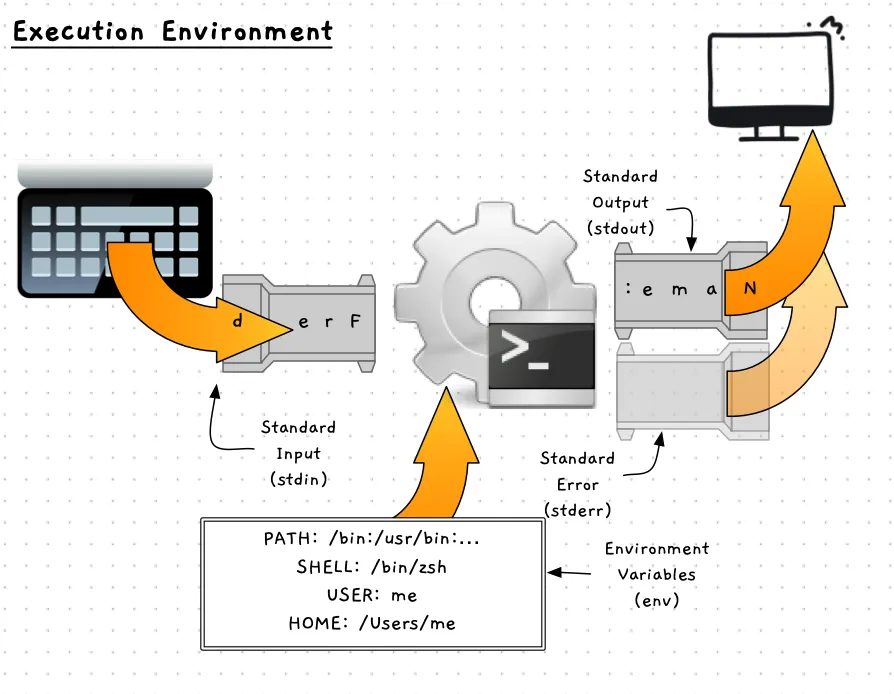Streams
Operating systems, like all programs, need to create digital realities for us to work with. We have seen how this is applied to data, which we can store and organise in files and folders. To understand how programs are executed within operating systems there is another concept we need to understand: data streams.
Data streams, often just referred to as streams, come from a river or water-flow metaphor. A stream is a flow of data either into or out of a program. You can picture this as the data flowing through a stream from a data source to a consumer. For example, data flows from the keyboard into a program which can respond to it. Similarly, data can flow out of the program and onto the terminal’s display for the user to see.
In Unix, streams are used as the metaphor for all data flows.
- File streams allow data to flow into or out of a file.
- Network streams allow data to flow between computers across a network.
- Text streams allow text to flow from things like the keyboard, and to things like the shell’s output.
Input, Output, and Errors
When you run a program, the operating system gives it three different data streams - one for input to be read, and two for outputs.
- Standard input (stdin) is a text input stream that your program can read.
- Standard output (stdout) is a text output stream that your program can write to.
- Standard error (stderr) is a second text output steam that your program can write error messages to.

Standard Input (stdin)
The standard input stream provides your program with text input that it can read. By default, the shell will stream data from the keyboard to your program while it is running.
Picture of data from the keyboard going into a program
Standard Output (stdout)
A program can write text output to its standard output stream. By default, the shell will stream this to the terminal for the user to see.
Picture of data from program going to the terminal
Standard Error (stderr)
A program can write text output to its standard error stream. By default, the shell will stream this to the terminal for the user to see.
Redirection
One of the great features of streams is the ability the operating system provides to redirect them. Using this feature, you can change where the data for standard input comes from, and where standard output and standard error go.
When running a program from the terminal, you can use different shell commands to redirect a program’s streams. The table below shows some of these commands.
| Action | Command | Description |
|---|---|---|
| Redirect stdout to new file | > | Send output to a new file |
| Append stdout to existing file | >> | Send output to the end of an existing file |
| Redirect stderr to new file | 2> | Send output to a new file |
| Append stderr to existing file | 2>> | Send output to the end of an existing file |
| Use a file to source stdin | < | Read the contents of a file as the program’s input |
To test out these commands, we need another cool utility called wc.
| Action | Command | Description |
|---|---|---|
| Count words | wc | Outputs the number of words, lines, or characters from stdin |
Use the following shell instructions to try out redirection.
echo "Here is a new file" > lines.txtls >> lines.txtcat lines.txt# the file will contain the message "Here is a new file"# and a list of the files in the current directory
ls . NO_FILE > lines.txt 2>&1cat lines.txt# the file will contain an error indicating that NO_FILE does not exist# and a list of files in the current directory
wc -l < lines.txt# outputs the number of lines in lines.txtPipes
Pipes offer another option for redirecting streams. In this case you can connect the output from one program to the input of another. This is a super powerful feature, allowing you to combine together multiple programs.
To explore this let’s look at one more tool: grep. Grep is an incredibly useful tool when combined with pipes. With grep you can filter standard input to only return lines that match patterns you define. For now, the patterns can just be exact text matches, but grep provides much more powerful pattern-matching capabilities which you can explore later.
| Action | Command | Description |
|---|---|---|
| Filter stdin | grep | Filter stdin and output only lines that match the given pattern |
| Connect programs | | | Send stdout from program to stdin of another |
Let’s try these out.
cat /etc/shells | grep sh | wc -l
# outputs the number of lines in /etc/shells that contain the text "sh"This command is three commands in one.
First, cat reads the file /etc/shells.
Normally cat would output the file contents to the terminal, but in this case the output is piped to be the input to grep.
grep filters this input to output only lines with “sh” in them, and that output is piped to wc.
wc then counts the number of lines it reads in its input.
Try the whole command, then try running the parts (e.g., just cat /etc/shells, then just cat /etc/shells | grep sh) to see how it is working.